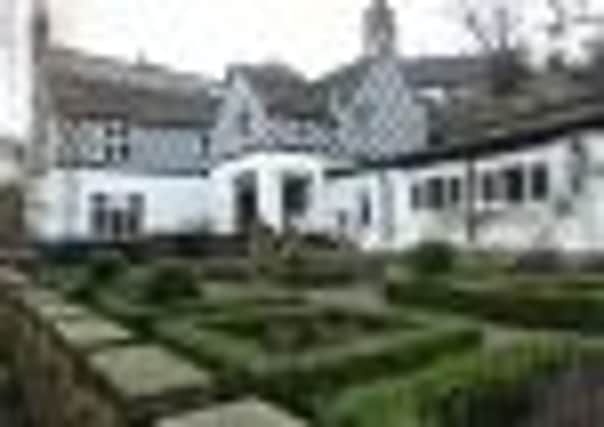Home with history and a heart of oak


Anyone who doubts it should take a look at the Old Manor House, in Knaresborough. The building is painted like a chessboard and, inside, there’s a tree in a cupboard. They just don’t make them like that any more.
The chequered livery is easy to explain. Quite simply, a former owner was a chess fanatic and decided to proclaim his passion through the medium of paint.
Advertisement
Hide AdAdvertisement
Hide AdThat was in the 1800s, and several Knaresborough buildings have since been given the black-and-white treatment, including the gatehouse of the town’s most famous tourist attraction, Mother Shipton’s Cave.


The tree, though, has a much more ancient story.
It is said that when King John – he of the Magna Carta – was staying at the castle, he would leave his retinue under a great oak tree on the riverbank while he went out hunting in the Forest of Knaresborough. By the time he came back, supper would be ready. Eventually, he built a hunting lodge around the tree. That was in 1208, and the venerable oak’s trunk and roots remain at the heart of the Old Manor House to this day.
Which means, of course, that the property, which is now a private residence, is seriously old. In fact, it is Knaresborough’s oldest building; even the castle was rebuilt a century later. The strangeness of the world in which it was built goes to prove Hartley’s dictum. When that tree was enclosed 800 years ago, Christianity hadn’t yet reached all of Europe, the printing press had yet to be developed, and the Isle of Man was ruled by Norway. America – along with its tomatoes, potatoes, chocolate and tobacco – would be science fiction for nearly three more centuries.
In fact, the Knaresborough men who built the Old Manor House wouldn’t even have spoken our language. Their northern Middle English would only have been slightly more intelligible to us than their lords’ Norman French. Some of them may well not even have adopted a fixed surname.


Advertisement
Hide AdAdvertisement
Hide AdOf course, the house has undergone changes in its time; a “modern” extension was built – in 1225 – and it was added to again in the early 17th and late 20th centuries. In the mid-1800s, it was dwarfed by Knaresborough’s massive viaduct, which rises 90 feet from the bottom of the garden to carry trains across the gorge between York and Leeds.
But the tree remains. Its lower branches used to spread out through the house, acting as ceiling beams, but they had to be removed in the late 20th century when rot got in. Yet much of the trunk – which is still rooted in place, if long since dead – was saved.
On the ground floor, it is concealed behind a slightly less ancient wooden door, and upstairs its squared-off stump sticks out of the landing floor, like a misplaced hitching post.
A few feet away, one of the bedrooms is known as the Candle Room. It has a small pentagon window where a candle would have been placed to let the castle know that the king had returned safely from his hunting trip.


Advertisement
Hide AdAdvertisement
Hide AdThe house’s royal connections don’t end with King John. In the water-front garden there’s a 400-year-old mulberry tree, believed to have been planted around 1608, when James I was trying to encourage the establishment of a national silk industry. (The attempt failed, because the black mulberry was planted to feed the silkworms instead of the white mulberry, which is what they actually eat).
James gave the house as a fishing lodge to his son, the future Charles I. It is said that Charles signed the Treaty of Capitulation in what is now called the Treaty Room after the Royalists’ defeat at the Battle of Marston Moor, in 1644.
In the dining hall, there is a discoloured flagstone which is said to mark the entrance to a filled-in tunnel that leads to the Church of St John the Baptist, further up the hill.
Legend has it that the shaft contains a donkey-skin map showing where Charles I’s regalia was buried to save it from Oliver Cromwell.


Advertisement
Hide AdAdvertisement
Hide AdIt was upstairs, in the main bedroom, that Cromwell stayed during the four-month siege of Knaresborough Castle. His bed, which had been in the house for more than 350 years, was sold off only eight years ago.
In the drawing room, which is panelled with oak so old it’s almost black, the carved faces of six men stare out of the magnificent fire-surround, dated 1661 – a gang of Royalists silently celebrating the Restoration of the monarchy.
You may think all this history would have produced its fair share of ghosts, but the current owners say there aren’t any. Which is surprising, perhaps, given that about a century ago, workers digging out the cellars unearthed the bones of a young woman and a cat in the stairwell. It has been speculated that the girl may have been bricked in as a witch with her familiar.
Despite its antiquity, the property has changed hands only five times. It passed from the Crown to the Church – the Archbishop of York is thought to have lived here – and was gifted to the Roundell family in the 1500s. They stayed until the 1950s, after which it became a tea-room, a guest-house and then a restaurant, before being bought and restored by the penultimate owners in the 1990s.
The Old Manor House’s black and white squares seem appropriate for a house with a chequered history, peopled by kings, bishops and knights.